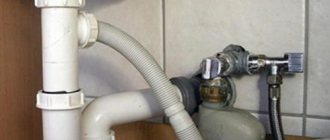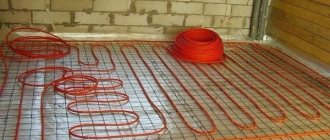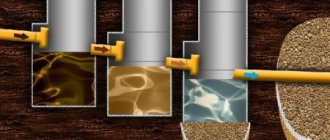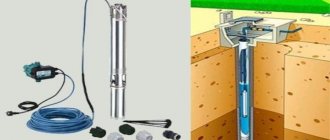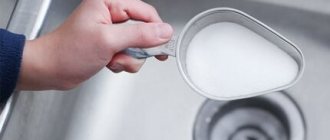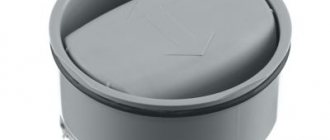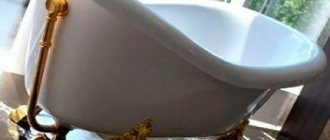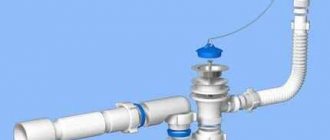Kitchen equipment is constantly being updated with new useful developments and useful devices. Some of them find their consumers very quickly, others take root gradually. One such useful device is the overflow sink siphon. It, of course, can no longer be called the latest in kitchen fashion, however, not everyone has been able to appreciate and take advantage of the useful qualities of such a modernized spout. Why is it attractive, what types of devices are there and how to install them, we will consider below in this article.
Why does a sink need outlet fittings with an overflow?
We all know the problem when the drains from the sink stop flowing or don’t flow well. This is usually a consequence of clogged drain fittings with grease deposits or pieces of solid waste. Since this situation repeats itself periodically, some may have the idea of connecting the sewer directly, eliminating the problematic siphon for the sink. Naturally, such a connection will help get rid of frequent small blockages, the outflow will speed up, since there will be no additional resistance to the flow, however, a number of other undesirable consequences will appear:
- unpleasant odors from the sewer;
- midges and other insects living in sewage areas;
- blockages in the depths of drain pipes, which are quite difficult to eliminate;
- If you accidentally drop a small valuable item, such as a ring, into the sink hole, you can say goodbye to it forever.
Siphon with overflow - protection against floods
Therefore, in order to prevent these troubles, you cannot do without installing drain fittings. In addition, an outlet for a sink with an overflow will save you and your neighbors from natural floods as a result of its accidental overflow.
Main types of siphons
Siphons for washbasins are classified according to the principle of their design. Having looked at the design in cross-section, the specialist will understand which one is better suited in a particular case. In addition, siphons are made of different materials, which determines their strength and durability.
Types of siphons.
Classification by device principle
There are 3 main types of siphons (although models from different manufacturers may differ in details). These include:
- Bottled. They are called flask-shaped because they include such a component in their design. In such systems, water enters the siphon, but moves inside through a separate pipe of smaller cross-section. When it reaches the bottom, the wastewater penetrates the cavity between the 2 cylinders and is then discharged into the sewer. Bottle systems are especially good for country houses, because they do not dry out even after prolonged inactivity. In addition, several drains are connected here at the same time.
- Pipe. Classic version, equipped with a pipe with a U/S bend.
- Mixed option. Includes bottle element and corrugated hose.
Pipe and mixed systems have proven themselves well in practice, especially in urban environments.
Division by material of manufacture
There are only 2 types of materials that are used to make siphons - plastic and metal, since they correspond to the purpose of the equipment and the conditions of its operation.
Plastic (or polymer) siphons are characterized by their low price and availability. In addition, their installation is so simple that you can easily do it yourself. Mold does not appear on the surface of such products, especially since manufacturers include antibacterial components in the composition. If we are talking about models equipped with a corrugated pipe, then one of the advantages is the ease of length adjustment.
But plastic sink siphons have disadvantages:
- short service life;
- When using them, it is impossible to achieve good sealing and you have to additionally use rubber gaskets.
Metal sink siphons also have advantages:
- strength;
- reliability;
- long service life;
- attractive appearance, since such structures are often made of brass and chrome-plated;
- protection from dirt deposits on the inside;
- ease of installation.
But metal siphons also have disadvantages:
- higher cost compared to plastic structures;
- Dirt deposits can build up on the inner walls, increasing the risk of clogging.
For non-standard equipment
In equipment manufactured for double sinks, siphons are needed with 2 outlets. They are connected simultaneously to the drains of both sinks. And then, at the required distance from the drain, they are again combined into 1 flask. Such models come in pipe or bottle versions.
Non-standard models include siphons for sinks installed on an open shelf. They are more expensive, but it is important to make sure that the unsightly plumbing fixture is invisible. Therefore, either choose an attractive brass element, or practice hidden installation, hiding the equipment behind a decorative screen or niche.
Connection materials and standards
In the production of the vast majority of models of overflow devices, polymeric materials are used: polyethylene or propylene. Brass, copper and stainless steel are less common, as they occupy the segment of high-quality expensive products. The chrome-plated sink siphon is distinguished by its special aesthetic sophistication, which will look impressive on plumbing fixtures installed in an open manner, without installing it in furniture or decorative structures.
Despite the huge variety of forms of outlet fittings, all of them are typical water seals, with the exception of the siphon of a dry design.
Thanks to the inert materials of modern water seals, they are not subject to corrosion, unlike their previous cast-iron counterparts, and the low roughness of their internal surfaces makes it difficult for fatty deposits to form. For the same reason, models in which the outlet and overflow channels are assembled from rigid pipes are preferable. Sometimes they are more difficult to assemble and connect to the sewer, however, they will have to be cleaned less often than flexible corrugated connectors. In addition, the strength and service life of corrugations, especially polymer ones, leaves much to be desired.
Overflow siphon-spark with outlet for washing machine
When choosing a siphon for a kitchen sink, it is important to determine the diameter of its outlet and overflow pipes. If Ø 25 mm is sufficient for an overflow, then the main outlet should be much thicker. Today, the most common standards are Ø32 mm and Ø 40 mm. For households where you have to cook a lot, and even more so when there is an abundance of fatty food, preference should be given to products with outlets Ø 40 mm, they are less susceptible to blockages. Convenient for connection is the drain fitting, which has an outlet of Ø32 mm or Ø 40 mm, adapted by a transition to Ø 50 mm for direct connection to a sewer of the same standard diameter.
On a note. All types of drain fittings with an overflow pipe can have additional outlets with Ø 19 mm herringbone fittings for connecting washing and dishwashing equipment, and can also be equipped with a bifurcated inlet designed for installation on a double sink.
Peculiarities
At the moment, plastic siphons are widely used. They have a number of advantages.
Articles on the topic (click to view)
- Rating of the best steamers of 2022
- Photos of curtains for kitchen design 2022
- Choosing curtains for the kitchen
- Metal kitchen rack for appliances
- Instructions for the electric stove "classic plus"
- How to choose an electric stove with 4 burners and an oven for the kitchen
- Sofa in the bay window for the kitchen
- Plastic is durable and resistant to corrosion and rotting.
- It is lightweight, unlike metal; you can install such a siphon even on a thin-walled sink.
- Plastic practically does not allow grease and dirt to settle on its surface, which prevents it from clogging.
- Its price is quite affordable.
Of course, you can install a drain made of brass or other metal, especially if your kitchen design requires it, but it will be more expensive and will last much less.
Device and types of products
The main element that characterizes a siphon for a sink with an overflow is the upper part of its collapsible body with an outlet for the overflow (overflow unit). This element, which is a tee, looks structurally the same in products of any type.
The overflow tube connected to the tee body can be corrugated or rigid. At the same time, rigid pipes are produced both solid, for certain models of plumbing, and sliding, the length of which can be adjusted for a specific model of equipment.
Overflow pipe siphon siphon for two sinks
The drainage from the overflow unit enters the water seal (the lower part of the siphon), the design of which determines what type of siphon for the kitchen sink is:
- Bottle type – a container resembling a bottle filled with water into which the outlet (through the intermediate pipe) of the tee body is immersed. Its cleaning is carried out by unscrewing the lower threaded part of the container. Discharge into the sewer can be done horizontally or at any angle through appropriate elbows.
- Pipe - a curved rigid tube assembled at threaded joints, which are disconnected during maintenance work. For the same purpose, some models may have an inspection plug at the bottom.
- Flat. It resembles a pipe one, however, the tube of its water seal is significantly flattened, which allows it to be installed in places with limited free volume. For example, this might look like a siphon for a sink above a washing machine.
- Corrugated – a curved corrugated soft tube. The corrugation is the hardest to clean; to do this, it will have to be disconnected and straightened. Just like a pipe water seal, it can be double-turn (S-shaped) or single-turn (P-shaped).
- Hidden. It is a system of channels, including overflow channels, cast in the body of the plumbing itself. In modern sinks and washstands, a hidden siphon is found quite often. Using such a design solution, it was possible to minimize the number of butt joints, which are always risk areas for leaks.
How to choose?
Expert opinion
Romanova Ksenia Petrovna
Interior design expert and fabric store manager
The types of siphons with overflow designs are varied. The most convenient are devices with automatic control of closing and opening drain holes.
If necessary, you need to press on the plug, which will close the hole and open it the next time you use it. However, due to the somewhat high cost of this option, the traditional siphon is more popular, which involves manually closing all the holes.
Some types of siphons are equipped with a special handle. She alone regulates the opening and closing of all holes. This is also a kind of automatic system.
The choice of plumbing fixture should be based not only on automation. The main parameters of siphons are dimensions.
Bottle-type devices are considered the most voluminous. This option is suitable if there is enough space at the installation point. If you plan to install a washing machine under the sink, then such a device will not work. The flat version is more compact. In this case, it will have to be placed under the sink.
Bottle siphons perform best in maintenance. It is this type of product that is considered suitable for a round double stone sink. A flat siphon, which is often installed in the bathroom, may not be suitable in size.
By the way, connecting other elements to the device requires the presence of additional connecting outputs. The device must have at least a pair of inlet fittings.
The siphon outlet can be made in the form of a regular lattice mesh. There are also technical devices with adjustable valves. Decide in advance whether you need this improvement so as not to overpay for it.
If the diameter of the siphon outlet pipe does not match the sewer pipe, you can use special adapters. However, this statement is only relevant if the size of the nozzle is smaller than the size of the pipe. Large-diameter pipes cannot be connected to the drain outlet.
Assembly and installation on the sink
The most common type of drain plumbing fittings are products with bottle designs. Despite the fact that they are somewhat more difficult to assemble than other types of products, they provide an optimal set of consumer characteristics. Therefore, let's look at how to assemble a sink siphon, complemented by an overflow function, based on a regular plastic bottle model. Installation will be easier if you initially completely screw together all the elements, thoroughly compress the threads and carefully position the gaskets, and then connect the finished product to the outlet and overflow holes of the sink.
Assembling a siphon for a sink, complemented by an overflow function
- We twist the two lower parts of the flask through a large flat gasket. The threaded cap (cup) is tightened until it stops, while you need to control the position of the gasket, preventing it from distorting.
- An intermediate pipe is inserted into the upper hole of the flask, which can be without an outlet or, if you have a siphon for a washing machine with or without a check valve, have an additional outlet to which a herringbone fitting is attached with a union nut through a flat gasket-valve. Union nuts must first be put on the upper and lower parts of the intermediate pipe, and then conical gaskets with the sharp parts facing outwards.
- We tighten the flask with the lower nut, and the overflow unit with the upper one.
- We insert and tighten the outlet pipe with a union nut and a cone gasket into the larger side hole of the flask, similar to the intermediate pipe. The outlet can be a straight or angled tube, or a corrugated hose.
- The same connection diagram is for the overflow tube, which must be connected at the lower end to the side outlet of the overflow tee, and at the top to the overflow pipe.
- Now you can attach the assembled structure to the outlet and overflow holes of the sink. The siphon for the kitchen sink is attached with screws to the corresponding holes through decorative grilles. For some models of plumbing fixtures, a decorative grille is provided only at the outlet hole, and the overflow is mounted by screwing a screw into the body of the overflow pipe through the wall of the sink. Regardless of the fastening features, flat elastic gaskets must be inserted from the side of the drain fittings.
All that remains is to connect the sink siphon with overflow to the sewer outlet. If the diameter of its outlet corresponds to the mounting diameter of the outlet, then it is simply tightly inserted through the o-ring into the sewer socket. To facilitate the operation and increase the reliability of the connection, silicone lubricants or sealants are used. If the outlet is thinner, then adapters or rubber cuffs with holes of suitable diameter are used.
Important! It is better to purchase the entire set of plumbing fixtures, including a siphon for a sink with overflow, at one retail outlet, so that unforeseen difficulties do not arise during installation of the equipment. This recommendation especially applies to products of non-standard designs and shapes.
How to install it yourself
The installation of the siphon begins with its assembly.
Initially, install all gaskets in their places. Then start assembling the structure. The flask is put on, the outlet pipe is screwed on, initially putting a threaded nut on it, and screwed to the flask. Next, the corrugated tube is attached to the middle hole of the siphon.
Installing the assembled siphon on the sink is not difficult. To do this, you need to put a gasket on the outlet of the siphon, and place the outlet grill on top of the sink, which comes complete with the siphon.
Expert opinion
Romanova Ksenia Petrovna
Interior design expert and fabric store manager
If your sink is equipped with its own outlet structure, then we use it. An overflow drainage system is connected to the outlet pipe on the side surface of the sink.
They are connected from different sides of the sink with a special screw. The corrugated pipe is connected to the sewer.
Now you need to turn on the water and check all connections for leaks.
- Once a week it is necessary to flush the drain with 4 liters of hot water, but not boiling water. This procedure will wash away all accumulated fat and rid the kitchen of unpleasant odors.
- Install an additional mesh over the outlet of the sink. It will prevent large debris from entering the drain, thereby preventing the sewer pipe from clogging. You can install an electric disposer that will grind the waste that ends up in the drain.
- Clean the siphon flask once a month.
- Sudden changes in water temperature can damage the plastic and connecting gaskets, so you should not suddenly throw boiling water into the sink after cold water.
- Do not wash greasy dishes with cold water, even if the hot water has been turned off; heat it in a kettle.
- Modern cleaning products, especially those containing chlorine and acid, have a harmful effect on both plastic and rubber gaskets, so their use should be limited. Vinegar, lemon, soda will help clean the siphon and return it to its original condition.
Of course, you can install any siphon on the sink, but if it is additionally equipped with an overflow protection for the sink, this will provide additional protection for your kitchen from flooding.
The appearance of this attribute of the drainage system, of course, plays a role, especially if the siphon is not hidden from view, but still the technical characteristics here should come to the fore. Therefore, before purchasing, you should consult with a specialist. Then it will last a long time and will not cause you any inconvenience.
We control the quality of installation
When completing installation activities, you should thoroughly rinse the entire system with water. For reliability, it is better to do this in three ways:
- open the mixer fully to maximum flow;
- close the drain, fill the sink to the overflow level and maintain the overflow for several minutes;
- open the drain by arranging a salvo discharge.
Sink with overflow hole
Such operations make it possible to ensure that the siphon for a sink with overflow is installed correctly - it ensures reliable drainage without leaks at the joints of parts. If leaks are still detected, you should check the quality of fit of the gaskets and tighten the threaded connections.
conclusions
An additional drainage device in sinks is an extremely useful thing; thanks to this improvement of the conventional siphon, the flood in the kitchen is canceled. It is also important that this can be achieved without much complexity in the design; all installation work can still be done independently, without the help of a professional plumber.
The video in this article shows an example of installing a water seal with an overflow.
Did you like the article? Subscribe to our Yandex.Zen channel
